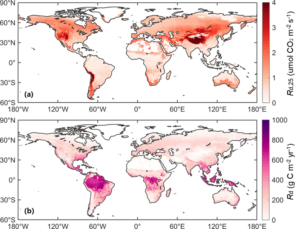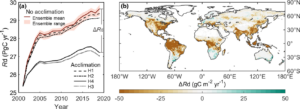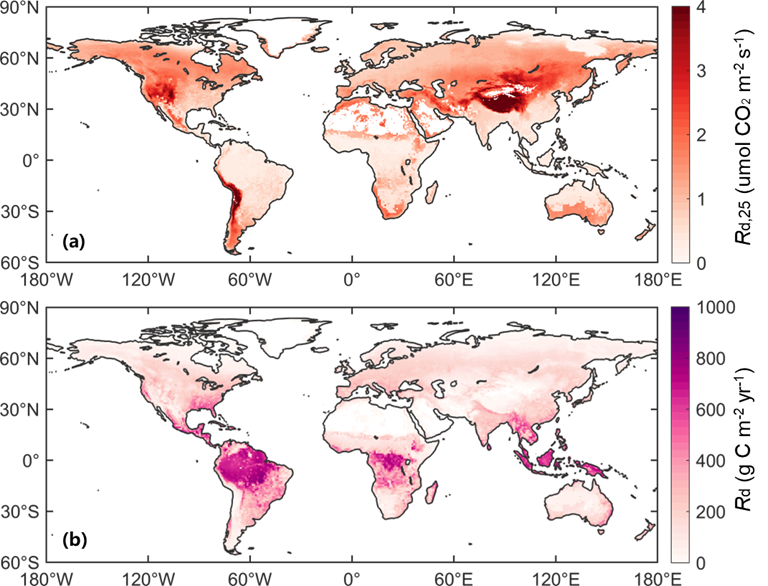Introduction
We are excited to share ground-breaking research published in the New Phytologist that explores the intricate world of leaf respiration in plants. This research, led by PhD student Yanghang Ren at Tsinghua University and involving members of the LEMONTREEE team and associates, delves into a fundamental aspect of plant life – how they breathe, or in more scientific terms, leaf respiration. This process is a crucial element of the global carbon cycle and plays a significant role in climate modelling.
Approximately a quarter of the carbon captured through photosynthesis by plants is released back into the atmosphere through leaf respiration. It’s a two-fold process that occurs both in the presence of light and in darkness, with temperature playing a key role in determining its rate. The intriguing aspect of leaf respiration is its ability to acclimate or adjust over time by down- or up-regulation of the basal respiration rate (Rd,25), a phenomenon explored through several hypotheses in this research. In this blog post, we’ll take you through some of the key findings from this research, titled:
Factors controlling the acclimation of leaf respiration
One of the central questions of this research was what factors drive the acclimation of leaf respiration (Rd,25). The study discovered that it’s a combination of night-time temperature (Tnight) and photosynthetic capacity (Vcmax) that provides the most accurate explanation for the variations in Rd,25. Among these factors, Tnight dominated the seasonal time-course of Rd,25, while Vcmax dominated the spatial patterns.
Hypotheses
- Temperature acclimation: Rd,25 acclimates to the daily average temperature (Tdaily) over a few days, with a linear decline in respiration as Tdaily It’s implemented in some models but introduces uncertainties due to PFT-specific parameters
- Rd and night-time temperature coupling: Rd,25 acclimates to prior night-time temperatures (Tnight), keeping night-time Rd within a narrow range of variation. This hypothesis suggests a connection between Rd and photosynthetic capacity, with higher Vcmax leading to greater night-time respiratory activity.
- Rd,25 and Vcmax,25 ration maintenance: Rd,25 maintains a fixed ratio to Vcmax25, following the standard photosynthesis model. This hypothesis is driven by the energy requirements for Rubisco and other enzymes, with Rd reflecting the need to sustain a specific amount of Rubisco. It’s linked to the ‘coordination hypothesis’ that aims for an optimal V
- Proposes that Rd,25 acclimates to night-time temperature to support Vcmax25, which, in turn, acclimates to daytime meteorological conditions, aiming for optimal photosynthesis, ensuring that the required ATP is provided through respiration both at night and during the day.
These four hypotheses were tested, and H4, which combines the effects of Tnight and Vcmax, demonstrated the best predictive power. It accurately captured the magnitude of variations in Rd,25, which can range from 0.57 to 2.17 μmol CO2 m–2 s–1. In contrast, H1 underestimated the variations, while H3 tended to underestimate larger respiration rates. Geographically, the combined effects of Tnight and Vcmax offered the best explanation for observed site-mean Rd,25, mostly diminated by Vcmax variability.
Time scales of acclimation
The research also delved into the timescale over which leaf respiration acclimates. The optimal averaging period for predicting Rd,25 variations under H4 was found to be 15 days, with the lowest root mean square error (RMSE). This means that acclimation of leaf respiration occurs most effectively over a 15-day period.
.
Fig. 1 Spatial patterns of (a) average-canopy Rd,25 and (b) annual whole-canopy leaf respiration from 2001 to 2019 simulated using H4. Average-canopy Rd,25 in panel (a) was simulated using the average environmental states for 2001-2019. The value of each grid was a weighted sum of the proportion of C3 and C4 plants. The distribution C3 and C4 plants was taken from Still et al. (2003).
The impact of acclimation on global leaf respiration
One of the key takeaways from this research is its potential impact on our understanding of the global carbon cycle. Global simulations using H4 showed that leaf respiration varies significantly with latitude, and it’s influenced by factors like temperature and solar radiation. Importantly, the study found that total global leaf respiration increased by 16% from 2001 to 2019 – more than 50% higher than the increase shown by H4 after accounting for acclimation of Tnight and Vcmax. Decreasing Vcmax,25 primarily explains the smaller increase in Rd produced by H4, in response to both warming and increasing atmospheric CO2 concentration (Fig. S14 b).

Fig. 2 The impact of acclimation on global leaf respiration from 2001 to 2019. (a) Simulated temporal changes in global total annual leaf respiration from 2001 to 2019. The black curves were simulated under the four acclimation hypotheses, H1, H2, H3 and H4. The red curve with shaded area shows the ensemble mean and range of the NOAH-MP, JULES, CLM4.0 and ORCHIDEE simulations. All predictions except H4 were rescaled based on the value of H4 in 2001. (b) The spatial distribution of the difference in Rd of H4 (solid black curve) and the ensemble mean (solid red curve) in 2019 (∆Rd). The global total annual leaf respiration in Fig.2a is the sum of Rd flux (unit: gC yr–1 per m2) of each 0.5° grid cell multiplied by the area of the grid
Discussion and implications
The findings of this research challenge some long-held assumptions in the field of plant physiology. For instance, the traditional belief that temperature plays a more significant role in leaf respiration than night-time temperature is debunked. Instead, it appears that night-time temperatures have a more substantial impact on leaf respiration, a discovery that could reshape our climate models and predictions.
Moreover, the introduction of a new hypothesis, H4, which combines the effects of night-time temperature and Vcmax, offers a more accurate and robust way to represent dark respiration in land surface models (LSMs). This approach could improve our understanding of how plants respond to changing environmental conditions, which is vital for predicting their role in the global carbon cycle.
In conclusion, this research opens new avenues for studying and understanding the intricate relationship between plants, temperature, and leaf respiration. It highlights the importance of night-time temperatures, challenging conventional wisdom, and paves the way for more accurate climate models and predictions.
You can read the full research paper here: Ren, Y., Wang, H., Harrison, S.P., Prentice, I.C., Atkin, O.K., Smith, N.G., Mengoli, G., Stefanski, A. & Reich, P.B. 2023. Reduced global plant respiration due to the acclimation of leaf dark respiration coupled to photosynthesis. New Phytologist. https://nph.onlinelibrary.wiley.com/doi/full/10.1111/nph.19355

